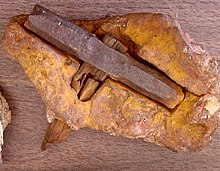London Hammer (artifact)
|
|
This article or section was due to content flaws on the quality assurance side of the editorial history entered. This is done in order to bring the quality of the articles in the field of history to an acceptable level. Articles that cannot be significantly improved are deleted. Please help fix the shortcomings in this article and please join the discussion ! |
The London Hammer (also known as the "London Artifact") is the name given to an iron and wood hammer that was found in London, Texas in 1934 . The unusual thing about the artifact is that it is firmly embedded in a limestone concretion, in a formation from the Cretaceous period . The London hammer is considered a typical " out-of-place artefact " in para-scientific circles .
Find history and investigations
The hammer was reportedly found in 1934 by a local couple, Max Hahn and his wife, Emma Zadie Hahn , while they were walking on the path of Red Creek near the city of London. They discovered a strange piece of loose rock with a piece of wood apparently embedded in it near a waterfall and took it home. A decade later, her son Max broke open the rock and found the hammer head hidden in it.
The dimensions of the metal hammer head were not used for large projects, but for fine work or soft metal. The metal of the hammer head should consist of 96.6% iron, 2.6% chlorine and 0.74% sulfur. The hammer head has not rusted since it was discovered in the mid-1930s. The hammer attracted greater attention after it was purchased in 1983 by creationist Carl Baugh , who claimed the artifact was a "monumental pre-Flood discovery". Baugh uses the hammer as the basis for speculation that the atmosphere on Earth prior to the Flood encouraged the growth of giants. The hammer is now part of an exhibit at Baugh's Creation Evidence Museum that is selling replicas of it to visitors. Radiocarbon dates were not carried out or no report is available.
Other experts have found that the hammer is stylistically consistent with typical American tools made in the region in the late 19th century. It corresponds to the typical hammer of a miner around 1880. One possible explanation for the surrounding rock that contains the artifact is that the highly soluble minerals in the old limestone can have formed a concretion around the object via a mineralogical process , as in nature also often occurs in similar incrustations around fossils and other nuclei.
Individual evidence
- ^ Glen J. Kuban: The London Hammer . 1986.
- ^ A b Kuban, The London Hammer, 2006
- ↑ Jim Middleton, The London Hammer , Historic Mysteries, July 20, 2011, accessed February 25, 2015
- ↑ M. Coppedge: Giant Humans and Dinosaurs .
- ↑ Keith Fitzpatrick-Matthews: The London Artifact (Texas) . In: Bad Archeology . May 9, 2007. Retrieved December 17, 2016.
